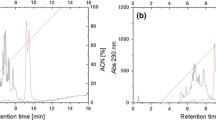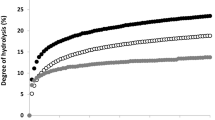Abstract
Purpose
The tryptophan-containing dipeptides isoleucine–tryptophan (IW) and tryptophan–leucine (WL) are angiotensin-converting enzyme (ACE)-inhibitors in vitro. These peptides are released by enzymatic hydrolysis of bovine whey protein. To exhibit ACE inhibition in vivo, peptides need to be absorbed into the circulatory system. This study aimed to determine the in vivo ACE-inhibitory potency of a whey protein hydrolysate (MPH), containing IW and WL, and to quantify plasma concentrations of these peptides after oral administration of MPH in healthy volunteers. Additionally, changes in blood pressure were investigated.
Results
After intake of 5 and 50 g MPH, plasma ACE activity was reduced to 86.4 ± 5.9 and 75.1 ± 6.9% of baseline activity, respectively. Although a clear ACE inhibition was measured, no effect on blood pressure was seen. Basal plasma concentrations of the tryptophan-containing dipeptides were 2.8 ± 0.7 nM for IW and 10.1 ± 1.8 nM for WL. After intake of 5–50 g MPH, peptide concentrations were dose dependently elevated to values between 12.5 ± 8.4 and 99.1 ± 58.7 nM for IW and 15.0 ± 4.3–34.9 ± 19.4 nM for WL. Administration of intact whey protein showed a minor ACE inhibition, probably caused by release of inhibitory peptides during gastrointestinal digestion. The increase of WL in plasma after intake of intact protein was similar to that determined after intake of MPH. In contrast, resulting IW concentrations were much lower after intake of intact whey protein when compared to MPH administration.
Conclusion
After intake of MPH, plasma ACE activity decreased in parallel to the increase of IW and WL plasma concentrations. However, the resulting peptide concentrations cannot fully explain the reduction of ACE activity in plasma with a direct enzyme inhibition. Therefore, this study points to a gap in the understanding of the inhibitory action of these peptides in vivo. Thus, to further develop innovative food additives with ACE activity diminishing capabilities, it appears mandatory to better characterize the mode of action of these peptides.






Similar content being viewed by others
Abbreviations
- IW:
-
Isoleucine–tryptophan
- WL:
-
Tryptophan–leucine
- W:
-
Tryptophan
- MPH:
-
Whey protein hydrolysate
- Intact MP:
-
Non-hydrolyzed whey protein
- ACE:
-
Angiotensin-converting enzyme
- RAS:
-
Renin–angiotensin-system
References
World Health Organization (WHO) (2014) Global status report on noncommunicable diseases 2014. WHO, Geneve, p 176
Borghi C, Rossi F (2015) Role of the renin–angiotensin–aldosterone system and its pharmacological inhibitors in cardiovascular diseases: complex and critical issues. High Blood Press Cardiovasc Prev 22:429–444
Carey RM, Siragy HM (2003) Newly recognized components of the renin–angiotensin system: potential roles in cardiovascular and renal regulation. Endocr Rev 24:261–271
Fanelli C, Zatz R (2011) Linking oxidative stress, the renin–angiotensin system and hypertension. Hypertension 57:373–374
Yusuf S, Sleight P, Pogue J, Bosch J, Davies R, Dagenais G (2000) Effects of an angiotensin-converting-enzyme inhibitor, ramipril, on cardiovascular events in high-risk patients. The Heart Outcomes Prevention Evaluation Study Investigators. N Engl J Med 342:145–153
Fox KM (2003) Efficacy of perindopril in reduction of cardiovascular events among patients with stable coronary artery disease: randomised, double-blind, placebo-controlled, multicentre trial (the EUROPA study). Lancet 362:782–788
Pfeffer MA, McMurray JJV, Velazquez EJ, Rouleau JL, Køber L, Aldo P, Maggioni MD, Solomon S, Swedberg K, Van de Werf F, White H et al (2003) Valsartan, captopril, or both in myocardial infarction complicated by heart failure, left ventricular dysfunction, or both. N Engl J Med 349:1893–1906
Collier S, Landram M (2012) Treatment of prehypertension: lifestyle and/or medication. Vasc Health Risk Manag 8:613–619
Chobanian AV, Bakris GL, Black HR, Cushman WC, Green LA, Izzo JL Jr, Jones DW, Materson BJ, Oparil S, Wright JT Jr, Roccella EJ (2003) The Seventh report of the Joint National Committee on prevention, detection, evaluation, and treatment of high blood pressure: the JNC 7 report. JAMA 289:2560–2572
Tao C, Dahai Y, Cornelius V, Rui Q, Yamei C, Zhixin J, Zhanzheng Z (2017) Potential health impact and cost-effectiveness of drug therapy for prehypertension. Int J Cardiol 240:403–408
Jung MH, Ihmb SH, Lee DH, Chung WB, Jung HO, Youn HJ (2017) Prehypertension is associated with early complications of atherosclerosis but not with exercise capacity. Int J Cardiol 227:387–392
Korhonen H, Pihlanto A (2006) Bioactive peptides: production and functionality. Int Dairy 16:945–996
Lunow D, Kaiser S, Brückner S, Gotsch A, Henle T (2013) Selective release of ACE-inhibiting tryptophan-containing dipeptides from food proteins by enzymatic hydrolysis. Eur Food Res Technol 237:27–37
Lunow D, Kaiser S, Rückriemen J, Pohl C, Henle T (2015) Tryptophan-containing dipeptides are C-domain selective inhibitors of angiotensin converting enzyme. Food Chem 166:596–602
Martin M, Wellner A, Ossowski I, Henle T (2008) Identification and quantification of inhibitors for Angiotensin-converting enzyme in hypoallergenic infant milk formulas. J Agric Food Chem 56:6333–6338
Daniel H (2004) Molecular and integrative physiology of intestinal peptide transport. Annu Rev Physiol 66:361–384
Kaiser S, Martin M, Lunow D, Rudolph S, Mertten S, Moeckel U, Deussen A, Henle T (2016) Tryptophan-containing dipeptides are bioavailable and inhibit plasma human angiotensin-converting enzyme in vivo. Int Dairy J 52:107–114
Matsui T, Tamaya K, Seki E, Osajima K, Matsumoto K, Kawasaki T (2002) Val-Tyr as a natural antihypertensive dipeptide can be absorbed into the human circulatory blood system. Clin Exp Pharmacol Physiol 29:204–208
Swagerty DL Jr, Walling AD, Klein RM (2002) Lactose intolerance. Am Fam Physician 65:1845–1850
FAO/WHO/UNU (2017) Technical report series 935: protein and amino acid requirements in human nutrition. WHO Press, Geneva, pp 1–265
Foex P, Sear J (2004) Hypertension: pathophysiology and treatment. Contin Educ Anaesth Crit Care Pain 4:71–75
Akpunonu BE, Mulrow PJ, Hoffman EA (1996) Secondary hypertension: evaluation and treatment. Dis Mon 42:609–722
Corring T (1980) The adaptation of digestive enzymes to the diet: its physiological significance. Reprod Nutr Dev 20:1217–1235
Ma X, Tian Z, Deng D, Cui Y, Qiu Y (2018) Effect of dietary protein level on the expression of proteins in the gastrointestinal tract of young pigs. J Agric Food Chem 66:4364–4372
Khedr S, Martin M, Deussen A (2015) Inhibitory efficacy and biological variability of tryptophan containing dipeptides on human plasma angiotensin converting enzyme activity. J Hypertens Open Access 4:2–6
Groneberg DA, Döring F, Eynott PR, Fischer A, Daniel H (2001) Intestinal peptide transport: ex vivo uptake studies and localization of peptide carrier PEPT1. Am J Physiol Gastrointest Liver Physiol 281:697–704
Jappar D, Wu SP, Hu Y, Smith DE (2010) Significance and regional dependency of peptide transporter (PEPT) 1 in the intestinal permeability of glycylsarcosine: in situ single-pass perfusion studies in wild-type and Pept1 knockout mice. Drug Metab Dispos 38:1740–1746
Smith DE, Clémençon B, Hediger MA (2013) Proton-coupled oligopeptide transporter family SLC15: physiological, pharmacological and pathological implications. Mol Asp Med 34:323–336
Walker D, Thwaites DT, Simmons NL, Gilbert HJ, Hirst BH (1998) Substrate upregulation of the human small intestinal peptide transporter, hPepT1. J Physiol 507:697–706
Ingersoll SA, Ayyadurai S, Charania MA, Laroui H, Yan Y, Merlin D (2012) The role and pathophysiological relevance of membrane transporter PepT1 in intestinal inflammation and inflammatory bowel disease. Am J Physiol Gastrointest Liver Physiol 302:484–492
Wang C-Y, Liu S, Xie X-N, Tan Z-R (2017) Regulation profile of the intestinal peptide transporter 1 (PepT1). Drug Des Devel Ther 11:3511–3517
Lu H, Klaassen C (2016) Tissue distribution and thyroid hormone regulation of Pept1 and Pept2 mRNA in rodents. Peptides 27:850–857
Khedr S, Deussen A, Kopaliani I, Zatschler B, Martin M (2018) Effects of tryptophan-containing peptides on angiotensin converting enzyme activity and vessel tone ex vivo and in vivo. Eur J Nutr 57:907–915
Sanchez-Rivera L, Ares I, Miralles B, Gomez-Ruiz J-A, Recio I, Martinez-Larranaga MR, Anadon A, Martinez MA (2014) Bioavailability and kinetics of the antihypertensive casein-derived peptide HLPLP in rats. J Agric Food Chem 62:1869–1875
van der Pijl P, Kies AK, Ten Have GAM, Duchateau GSMJE, Deutz EP (2008) Pharmacokinetics of proline-rich tripeptides in the pig. Peptides 29:2196–2202
Matsui T, Imamura M, Oka H, Osajima K, Kimoto K-I, Kawasaki T, Masumoto T (2004) Tissue distribution of antihypertensive dipeptide, Val-Tyr, after its single oral administration to spontaneously hypertensive rats. J Peptide Sci 10:535–545
Li H, Aluko RE (2010) Identification and inhibitory properties of multifunctional peptides from pea protein hydrolysate. J Agric Food Chem 58:11471–11476
Wuerzner G, Peyrard S, Blanchard A, Lalanne F, Azizi M (2009) The lactotripeptides isoleucine-proline-proline and valine-proline-proline do not inhibit the N-terminal or C-terminal angiotensin converting enzyme active sites in humans. J Hypertens 27:1404–1409
Funding
This work was supported by a grant-in-aid from the Federal Ministry of Education and Research of Germany, BMBF (Grant Number 03V0538).
Author information
Authors and Affiliations
Corresponding author
Ethics declarations
Conflict of interest
The authors declare that they have no conflict of interest.
Ethical standards
The authors declare that all human studies have been approved by the appropriate ethics committee and have therefore been performed in accordance with the ethical standards laid down in the 1964 Declaration of Helsinki and its later amendments.
Electronic supplementary material
Below is the link to the electronic supplementary material.
Rights and permissions
About this article
Cite this article
Martin, M., Hagemann, D., Nguyen, T.T. et al. Plasma concentrations and ACE-inhibitory effects of tryptophan-containing peptides from whey protein hydrolysate in healthy volunteers. Eur J Nutr 59, 1135–1147 (2020). https://doi.org/10.1007/s00394-019-01974-x
Received:
Accepted:
Published:
Issue Date:
DOI: https://doi.org/10.1007/s00394-019-01974-x




